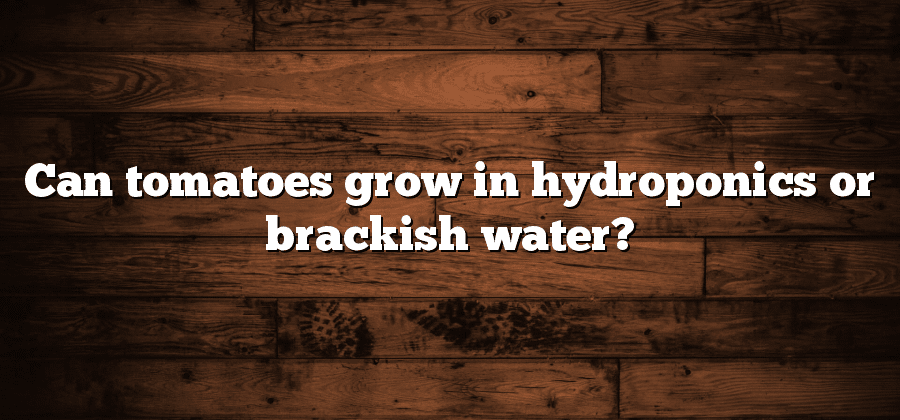Understanding Hydroponics as a Modern Growing Method
Hydroponics is a modern method of growing plants that is gaining popularity in agricultural and horticultural circles. In this innovative system, plants are grown without soil, using water fortified with essential nutrients. This method has several advantages over traditional soil-based cultivation, making it an attractive option for growers worldwide.
One of the primary benefits of hydroponics is the ability to control and optimize the growing conditions for plants. With this method, growers can adjust the nutrient levels, pH balance, and temperature of the water to create an ideal environment for plant growth. This precision allows plants to receive the essential elements they need in exact quantities, leading to healthier and more vigorous growth. Additionally, hydroponics eliminates the risk of soil-borne diseases and pests, creating a cleaner and more hygienic growing environment. As a result, hydroponic systems often yield higher crop yields compared to traditional soil-based methods.
The Potential of Tomatoes in Hydroponic Systems
Tomatoes are one of the most widely grown and consumed crops in the world, and hydroponic systems offer a promising method for their cultivation. Hydroponics eliminates the need for traditional soil-based planting by allowing the plants to grow in a nutrient-rich water solution. This controlled environment not only optimizes resource utilization but also provides better control over factors such as temperature, pH, and nutrient levels. As a result, tomatoes grown in hydroponic systems tend to have higher yields, richer flavors, and improved nutritional content compared to those grown in traditional soil-based methods.
The potential of tomatoes in hydroponic systems extends beyond their quality and quantity of production. With hydroponics, it is also possible to grow tomatoes in non-traditional areas, such as urban environments or regions with limited arable land. This opens up opportunities for year-round tomato production and reduces the reliance on agricultural practices that may be detrimental to the environment. Furthermore, hydroponic tomatoes are less prone to diseases and pests commonly associated with soil-based cultivation, reducing the need for chemical treatments. Thus, the potential of tomatoes in hydroponic systems not only benefits farmers and consumers but also offers sustainable solutions for the future of agriculture.
Examining the Challenges of Using Brackish Water in Hydroponics
Brackish water, with its high salt content, poses numerous challenges when it comes to utilizing it in hydroponic systems. One of the main challenges is the potential impact on the plants’ nutrient uptake. The excessive salt concentration in brackish water can interfere with the plants’ ability to absorb essential nutrients, leading to stunted growth and decreased yields. Additionally, the salt accumulation in the growing medium can affect the pH level, potentially causing imbalances and further hindering nutrient availability.
Another significant challenge is the potential damage to the hydroponic equipment. Brackish water, with its corrosive properties, can degrade the infrastructure of the system, such as pipes, pumps, and valves, leading to leakages and malfunctions. This not only poses a significant financial burden but also disrupts the stability of the overall hydroponic production. Moreover, the increased salt levels in brackish water can also result in the accumulation of salts in the irrigation system, further diminishing its efficiency and impeding nutrient delivery to the plants.
Therefore, understanding and addressing these challenges is of paramount importance for those considering or already using brackish water in their hydroponic setups. By implementing appropriate strategies and technologies, it is possible to overcome these obstacles and harness the potential of brackish water for sustainable hydroponic cultivation. The following section will delve into the various techniques and considerations necessary for adapting hydroponic techniques to brackish water environments.
Adapting Hydroponic Techniques for Brackish Water Environments
To successfully adapt hydroponic techniques for brackish water environments, growers must first understand the unique challenges posed by this type of water. Brackish water contains higher levels of salinity than fresh water, making it unsuitable for traditional hydroponic systems. This high salinity can negatively impact plant growth and nutrient uptake, potentially leading to stunted growth or reduced yields.
One technique that can be employed to adapt hydroponics for brackish water environments is the use of specialized filtration systems. These systems are designed to remove excess salts and minerals from the water, thereby reducing the salinity levels and creating a more suitable growing environment for plants. Additionally, growers may choose to use alternative nutrient solutions that are better suited to brackish water. These solutions often contain lower levels of salts and minerals, allowing plants to thrive despite the higher salinity levels in the water.
By applying these adaptation techniques, hydroponic growers can overcome the challenges posed by brackish water environments and continue to cultivate healthy and productive plants. However, it is important to note that each brackish water source may have unique characteristics, and growers must carefully monitor and adjust their hydroponic systems to ensure optimal growing conditions for their specific crops.
Exploring the Effects of Brackish Water on Tomato Growth
Brackish water, with its elevated salinity levels and unique composition, presents a formidable challenge for hydroponic growers seeking to optimize crop yields. When it comes to tomato cultivation, brackish water can significantly impact the growth and development of these popular fruits.
One of the key effects that brackish water has on tomato growth is its influence on nutrient absorption. As tomatoes rely on an optimal balance of nutrients for healthy growth, the increased salinity in brackish water can hamper this delicate equilibrium. Excessive amounts of salt in the water can disrupt the plant’s ability to take up essential nutrients, leading to nutrient deficiencies and stunted growth. Additionally, the high salt content can cause an imbalance in osmotic pressure, affecting the water potential in plant cells and leading to cellular dehydration. It is crucial for researchers and growers to explore strategies to mitigate the negative effects of brackish water on tomato growth to ensure sustainable and productive hydroponic systems.






